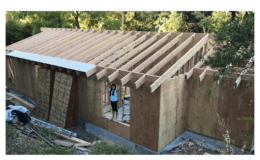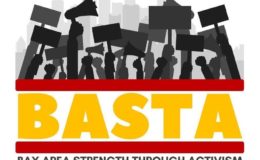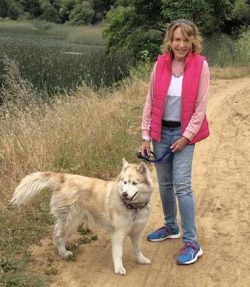Good Job Paul
An interview with Paul Keim of Smalltown Space
- By : Kevin Seal
- Category : Community, Featured Story

You may have met Paul Keim around Castro Valley. He’s a baseball coach for Castro Valley Little League, a husband, a father of four, and a bandleader – his folk-pop ensemble, Smalltown Society, specializes in literate lyrics, vocal harmonies, and acoustic arrangements. Their debut album, A Road Most Traveled, is a thematically-linked, novelistic recording, best experienced as one continuous, 70-minute listen.
Keim recently embarked on a project to bring a community space to Castro Valley. The building where this project is taking root is a standalone structure at 22222 Redwood Road, adjacent to the Trader Joe’s grocery store. Castro Valley Matters recently interviewed him to learn more about Smalltown Space.
CVM: What is the Smalltown Space?
Keim: The long answer is that we wanted to create a space that both highlights and cultivates art and advocacy in the Eden Area. We wanted a place that encourages dialogue, as opposed to debate, and reconciliation across social barriers. This would be a place for conversation and action regarding local economics, sustainable agriculture, about work and rest and cooperation. The short answer is that we want to be part of creating, sharing, and participating in a better narrative.
CVM: The Space has a sound system now, and a piano. Could you tell us about the piano?
Keim: The Chung family donated the piano to the Space, and we are really appreciative for their generosity. That piano had been in the Chung family for generations, and Dale Chung, a terrific jazz pianist, composer, and arranger, offered to let us make use of it. Dale’s great-grandfather was buddies with Jack London, and so Jack London played that piano a bunch when he was hanging out with the Chungs around the turn of the 20th century. That piano has a lot of history, and a lot of vibe, but it needs some work. Soon we are hoping to stage a fundraiser to get the piano restored to great performing shape – not just tuned up, but fully restored.
CVM: What kinds of events are happening in the Space so far?
Keim: Anything from evenings highlighting artists and advocates, to reading groups – we just finished a group about David Byrne’s book, How Music Works – to music lessons, and jam sessions, and an ongoing conversation about local economics and local agriculture.
CVM: How do people find out about these events?
Keim: Currently, we are announcing them over social media, and on SmalltownSociety.com, and by word of mouth. We’ll be a bit more public about it soon, though. Once the Space is public, we will be open as an art gallery and pop-up shop. All of it will highlight local artists and support local, small businesses.
CVM: Is it open to kids too?
Keim: Yes sir! It’s all ages! We’re also currently working out a child-care situation for some events, where parents can drop their kids off at First Presbyterian Church next door, and then come over to the Space for a few hours.
CVM: What events have you had so far that address local organizing?
Keim: We’ve had one evening so far where we addressed a lot of different topics, including local economics. That meeting has become a catalyst for an ongoing listening and working group, in order to engage more directly in localized organizing. A lot of ideas are coming up – some created from the Space, and some that have already been underway. We simply want to listen, learn, and highlight the work that people are doing already. For instance, we hosted a representative of Mandela Marketplace in February. The work they have committed to in Oakland over the past nine years, as well as the market that they are hoping to open this year in the Ashland area, is inspiring to say the least.
CVM: Very good news for Ashland.
Keim: We’re just entering into this narrative, and discovering many amazing communities already doing great work. So we don’t need to re-invent the wheel. We just need to enter into the narrative, and be a part of its success.
CVM: What might people learn about local agriculture, hypothetically?
Keim: They might learn the history and context for why we need to work toward a localized economy. Or why it’s important for our community to take back the reins of our food system, and to learn who is already paving the way in this field. Ultimately, collectively, we want to ignite a common vision with other local organizations – neighborhoods converging to grow food, protect seeds, nurture the soil, build community, foster a healthy local economy, and work for food security and water security. We want to educate the coming generations on how to properly and ethically cultivate to second most important resource on our planet. Again, we’re just beginning, and we hope that, as we continue, the vision will be a collective and inclusive one. I hope it will be a place where not just art and advocacy converge, but where the average citizen can come into contact with local government, and local officials can come into contact with the strengths of its “average” citizen.
CVM: Have you had Trader Joe’s shoppers hear what’s happening in the Space and stop in?
Keim: We have had a few! I think there would be more if they knew it was for them as well. Once the Space is more public, hopefully people will feel more comfortable to just walk in. They’re welcome to.
CVM: How did this project come into existence?
Keim: It ultimately started with my band, Smalltown Society. We were writing songs that engaged with the stories for meaning and justice. The more we engaged in these stories, the more I wanted to be a part of the redemptive narrative in my neighborhood. My heart was really telling me to form a community that was for the community. My wife and I decided to take a chance, and with the major support of First Presbyterian Church of Hayward, we’ve been able to get this project slowly off the ground. Honestly, we’re still in the infant stages. For the first four months, all we really did was listen to the community, and to experience the strengths already present. The first thing we did, coming out of that season, was to launch the monthly gatherings where we highlight these strengths.
For more information on the Space and its upcoming events, please visit http://SmalltownSociety.com



